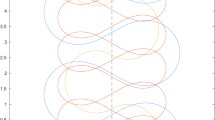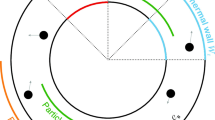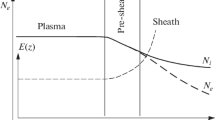Abstract
The specific features of free (outside a conductor) motion of charged particles in the field of a vector potential produced by a direct current flowing in a cylindrical or a flat conductor are considered. It is shown that when particles with negative charge move along the current direction (as well as when positively charged particles move in the opposite direction), the process of interaction of charges with the vector potential of the current corresponds to the presence of a very deep potential well whose minimum lies outside the conductor. This position of the minimum of the potential well corresponds to the flow of a current whose strength does not exceed several kiloamperes for electrons and positrons and several tens of kiloamperes for protons. When these values are exceeded, the minimum shifts into the bulk of the conductor. When the current decreases or the longitudinal energy of a particle increases, the position of the minimum varies in the range from near the surface of the conductor to values that are many tens of times greater than the thickness (diameter) of the conductor. The depth of the potential well increases with increasing energy of a particle and may reach tens and hundreds of kiloelectronvolts even for nonrelativistic particles. The structure of the potential well near the surface of a flat conductor with current corresponds to a harmonic oscillator whose frequency depends on the current strength, the thickness of the flat conductor, and the particle energy. The presence of such features makes it possible to implement a nondissipative channeling regime outside the conductor and the transportation of particles over a long distance.




Similar content being viewed by others
REFERENCES
J. Lindkhard, Mat.-Fys. Medd. Dan. Vid. Selsk. 34 (14) (1965).
D. S. Gemmel, Rev. Mod. Phys. 46, 129 (1974).
Y. H. Ohtsuki, Charged Beam Interaction with Solids (Taylor and Francis, London, 1983).
V. M. Biryukov, V. I. Kotov, and Yu. A. Chesnokov, Phys. Usp. 37, 937 (1994).
E. Schrodinger, Ber. Kgl. Akad. Wiss. 24, 296 (1930).
H. P. Robertson, Phys. Rev. A 35, 667 (1930).
V. V. Dodonov and V. I. Man’ko, Tr. FIAN 183, 71 (1987).
V. V. Dodonov, A. V. Klimov, and V. I. Man’ko, Tr. FIAN 200, 56 (1991).
V. I. Vysotskii and M. V. Vysotskyy, Eur. Phys. J. A 49, 99 (2013).
V. I. Vysotskii, S. V. Adamenko, and M. V. Vysotskyy, Ann. Nucl. Energy 62, 618 (2013).
V. I. Vysotskii and M. V. Vysotskyy, J. Exp. Theor. Phys. 118, 534 (2014).
V. I. Vysotskii and M. V. Vysotskyy, J. Exp. Theor. Phys. 120, 246 (2015).
V. I. Vysotskii and M. V. Vysotskyy, J. Exp. Theor. Phys. 128, 856 (2019).
D. Letts, D. Cravens, and P. Hagelstein, in Low-Energy Nuclear Reactions Sourcebook (Am. Chem. Soc., Washington, DC, 2009), Vol. 2, p. 81.
S. Lipinski and H. Lipinski, Intern. Patent WO2014/189799 A9 (2014).
V. I. Vysotskii, M. V. Vysotskyy, and S. Bartalucci, J. Exp. Theor. Phys. 127, 479 (2018).
S. Bartalucci, V. I. Vysotskii, and M. V. Vysotskyy, Phys. Rev. Accel. Beams 22, 054503 (2019).
Author information
Authors and Affiliations
Corresponding author
Additional information
Translated by I. Nikitin
Rights and permissions
About this article
Cite this article
Vysotskii, V.I., Vysotskyy, M.V. Features of Nondissipative Channeling of Moving Particles Near a Conductor with Current. J. Exp. Theor. Phys. 132, 18–26 (2021). https://doi.org/10.1134/S1063776120120079
Received:
Revised:
Accepted:
Published:
Issue Date:
DOI: https://doi.org/10.1134/S1063776120120079




